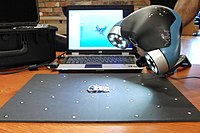
Photo from wikipedia
Abstract. In fringe projection profilometry (FPP), non-sinusoidal fringes due to the gamma effect of a projector will cause measurement errors. To solve this problem, a binary defocusing technique has been… Click to show full abstract
Abstract. In fringe projection profilometry (FPP), non-sinusoidal fringes due to the gamma effect of a projector will cause measurement errors. To solve this problem, a binary defocusing technique has been introduced in recent years, yet the appropriate defocusing is hard to evaluate quantitatively. An innovative approach to quantify binary defocusing in real-time is proposed. No matter how the projector and camera are arranged in FPP system, the fringe period in a captured defocusing fringe image is strictly varying; therefore, unlike previous methods, the proposed method uses a limited window for defocusing evaluation. This not only improves the accuracy of defocusing evaluation, but also greatly improves the evaluation speed, thus in turn enabling real-time evaluation. In addition, numerical differentiation is introduced on the window using a modified five-interval-point algorithm to effectively improve the sensitivity to improper (inadequate or excessive) defocusing. The difference between the numerical differentiation and its fundamental harmonic extracted by Levenberg–Marquardt iterative is taken as an evaluation value of binary defocusing. The smaller the difference, the more appropriate is the defocusing. By minimizing this difference, the most appropriate defocusing can be obtained quantitatively. Both numerical simulations and experiments validate the high sensitivity and high speed of the proposed method.
Journal Title: Optical Engineering
Year Published: 2021
Link to full text (if available)
Share on Social Media: Sign Up to like & get
recommendations!